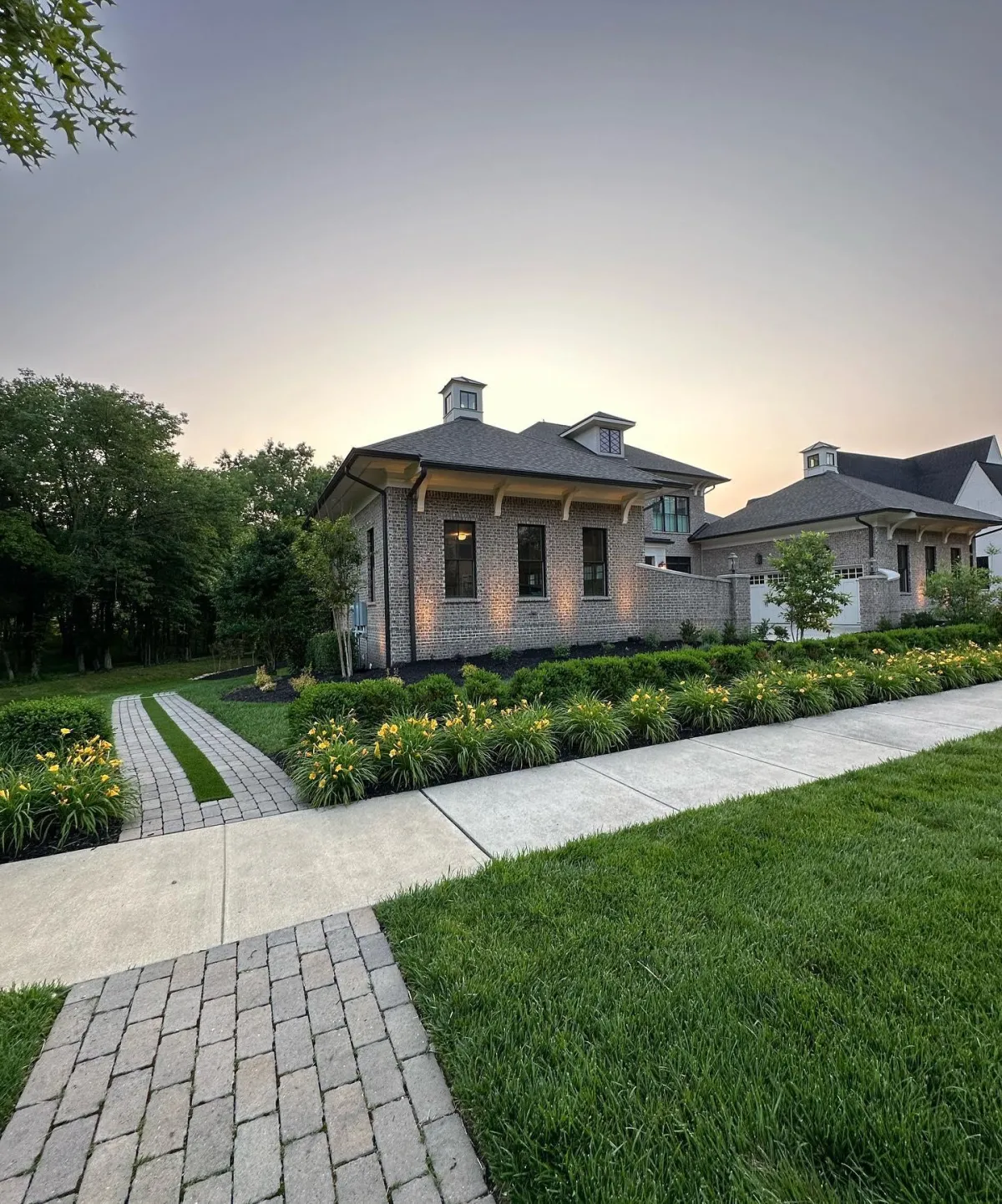Blogs

Can Landscaping Improve Energy Efficiency For Your Property?
Yes, landscaping can improve energy efficiency for your property by providing shade, reducing heat absorption, and creating windbreaks, which can lower heating and cooling costs. Imagine transforming your yard into a lush, beautiful oasis that not only looks amazing but also helps you save on energy costs. This isn't just a fantasy—strategic landscaping can significantly boost your property's energy efficiency. Titus Landscaping, a renowned landscaping company in Murfreesboro, specializes in creating energy-efficient landscapes that benefit both your wallet and the environment.
Key Takeaways
Shading: Use deciduous and evergreen trees to reduce cooling and heating costs.
Windbreaks: Plant evergreen trees to block cold winter winds.
Evapotranspiration: Utilize plants to cool the air around your home.
Air Circulation: Improve insulation with vines, shrubs, and bushes.
Water Efficiency: Implement xeriscaping for water and energy savings.
Solar Gain: Reduce solar gain by planting trees and shrubs strategically.
How Landscaping Improves Energy Efficiency
Landscaping isn't just about aesthetics; it's a powerful tool for improving your home's energy efficiency. Here are some ways it can make a difference:
Shading
Strategically planting trees can provide natural shading, reducing the need for air conditioning in the summer and improving its efficiency by up to 10%. Deciduous trees with high crowns are perfect for blocking intense summer heat.
Windbreaks
Evergreen trees and shrubs can act as windbreaks, blocking cold winter winds and reducing the energy required for heating your home. Properly placed windbreaks can significantly cut down on your heating bills.
Evapotranspiration
Plants cool their surroundings through evapotranspiration, a process that can lower the temperature around them by up to 9 degrees. This natural cooling effect reduces the need for artificial cooling.
Air Circulation
Vegetation like vines, shrubs, and bushes can improve air circulation around your home. They create an insulating bubble of air, keeping your home warmer in winter and cooler in summer.
Water Efficiency
Xeriscaping, a water-efficient landscaping method, not only conserves water but also reduces the energy needed for irrigation and maintenance. It's a win-win for your wallet and the environment.
Solar Gain
By planting trees or shrubs that cast shadows on your home's windows during peak sunlight hours, you can reduce solar gain and lower your cooling costs. This simple strategy can lead to significant long-term savings.
Shading
Benefits of Deciduous Trees
Deciduous trees, such as maples and oaks, lose their leaves in winter, allowing sunlight to warm your home. In the summer, their dense foliage provides shade, reducing the need for air conditioning.
Benefits of Evergreen Trees and Shrubs
Evergreens, like pine and spruce, offer year-round benefits. In the summer, they provide shade, and in the winter, they act as windbreaks, protecting your home from cold winds.
Windbreaks
How Evergreen Trees Create Windbreaks
Evergreens are perfect for creating windbreaks. When planted strategically, they can block prevailing winter winds, reducing the amount of cold air that hits your home and lowering your heating costs.
Positioning Trees to Block Cold Air
To maximize their effectiveness, plant evergreen trees on the north and northwest sides of your home. This placement will block the coldest winds and provide the best protection.
Evapotranspiration
Explanation of Evapotranspiration
Evapotranspiration is the process by which plants release water vapor into the air. This process cools the air around them, similar to how sweating cools your body.
Impact on Surrounding Temperature
By incorporating a variety of plants in your landscaping, you can create a cooler microclimate around your home. This reduces the need for artificial cooling, saving energy and money.
Air Circulation
Using Vines, Shrubs, and Bushes for Insulation
Planting vines, shrubs, and bushes near your home can create an insulating layer of air. This natural insulation helps keep your home warmer in winter and cooler in summer.
Seasonal Benefits
In winter, this layer traps warm air close to your home, reducing heating costs. In summer, it provides shade and cools the air, reducing cooling costs.
Water Efficiency
Introduction to Xeriscaping
Xeriscaping is a landscaping method that focuses on water conservation. It involves using drought-tolerant plants and efficient irrigation techniques.
Benefits of Water-Efficient Landscaping
Xeriscaping reduces the amount of water needed for your landscape, saving you time and money. It also reduces the energy required for irrigation and maintenance, contributing to overall energy efficiency.
Solar Gain
Planting Strategies to Reduce Solar Gain
To minimize solar gain, plant trees or shrubs that will cast shadows on your home's windows during the hottest parts of the day. This simple strategy can significantly reduce your cooling costs.
Long-Term Energy Bill Savings
Over time, reducing solar gain can lead to substantial savings on your energy bills. It's a simple yet effective way to enhance your home's energy efficiency.
Sustainable Landscaping
Sustainable landscaping focuses on creating environmentally friendly and energy-efficient landscapes. It involves using native plants, conserving water, and reducing waste. By adopting sustainable landscaping practices, you can create a beautiful and eco-friendly yard.
Choosing the Right Plants for Energy Efficiency
Selecting the right plants is crucial for energy-efficient landscaping. Native and drought-tolerant plants require less water and maintenance, making them ideal for xeriscaping. Additionally, choosing the right mix of deciduous and evergreen trees can maximize shading and windbreak benefits.
The Role of Soil Health in Landscaping
Healthy soil is the foundation of any successful landscape. It supports plant growth, improves water retention, and reduces the need for chemical fertilizers. By enhancing soil health through composting and organic practices, you can create a thriving, energy-efficient landscape.
Innovative Landscaping Ideas for Small Yards
Even small yards can benefit from energy-efficient landscaping. Vertical gardens, container gardening, and small-scale xeriscaping are all great options. These innovative ideas can maximize the use of limited space while still providing energy-saving benefits.
The Economic Benefits of Landscaping
Investing in landscaping can increase your property's value and curb appeal. Energy-efficient landscaping not only reduces utility bills but also attracts potential buyers. It's a smart investment that pays off in both the short and long term.
FAQs
How can landscaping save energy?
Landscaping saves energy by providing natural shade, creating windbreaks, and enhancing air circulation. These factors reduce the need for artificial cooling and heating, leading to lower energy bills.
What types of plants are best for energy-efficient landscaping?
Deciduous trees, evergreen trees, and drought-tolerant plants are ideal for energy-efficient landscaping. They provide shade, act as windbreaks, and require less water and maintenance.
How does xeriscaping contribute to energy savings?
Xeriscaping reduces the need for irrigation and maintenance, saving water and the energy required for these tasks. It involves using drought-tolerant plants and efficient irrigation techniques.
Can landscaping improve indoor air quality?
Yes, plants can improve indoor air quality by filtering pollutants and releasing oxygen. Strategic placement of plants around your home can enhance both outdoor and indoor air quality.
What is the cost-benefit analysis of energy-efficient landscaping?
While the initial investment in energy-efficient landscaping may be higher, the long-term savings on energy bills and increased property value make it worthwhile. Over time, the energy savings can offset the initial costs.
Transform Your Yard and Save Energy with Titus Landscaping
Investing in energy-efficient landscaping is a smart way to enhance your property's beauty while reducing energy costs. By incorporating strategies like shading, windbreaks, and xeriscaping, you can create a sustainable and cost-effective landscape. Titus Landscaping in Murfreesboro is dedicated to helping you achieve these benefits with their expert services.
Ready to transform your yard into an energy-efficient oasis? Contact us at Titus Landscaping today to start your journey toward a beautiful, sustainable landscape. Our team of experts is here to help you every step of the way.
THE BEST IN LANDSCAPE & OUTDOOR LIVING
Get your free quote today!
Contact Us
Rockvale, Tennessee 37153
Mon - Fri 8:00 am - 6:00 pm
Follow Us
© 2025 Titus Landscape. All Rights Reserved. Privacy Policy. Terms & Conditions. Web Design by Fused Media

